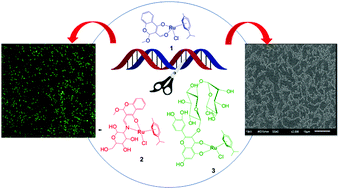Novel ruthenium arene complexes of flavonoid derivatives were synthesized and characterized. The structure of complex 1 was determined by single-crystal X-ray crystallography. Ruthenium complexes display strong DNA interactions. Zero-order relativistic approximation (ZORA) was employed for the B3LYP/DFT calculation to validate the structures of 2 and 3. Frontier molecular orbital (FMO) analysis was performed for getting a trend of DNA binding propensity of the complexes. The ruthenium complexes 1–3 were tested against pathogens, viz. Pseudomonas aeruginosa PAO1, Chromobacterium violaceum ATCC 12472, and methicillin-resistant S. aureus (MRSA). The ruthenium complexes exhibited potential acting as biofilm inhibitors and showed significant activity as quorum sensing inhibitors. Scanning electron microscopy (SEM) and confocal microscopy visualized biofilm inhibition, and a substantial reduction in microcolonies was observed. Furthermore, essential quorum sensing (QS) regulated functions that play a crucial role in biofilm formation were also studied, i.e., exopolysaccharide (EPS) production and swarming motility. A significant reduction was recorded at the tested sub-MICs.

